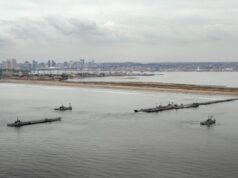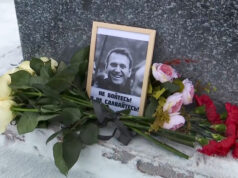
U.S. President Barack Obama meets with Russian President Dmitry Medvedev in 2012. At the bilateral meeting, Obama was overheard asking for time—”particularly with missile defense”—until he is in a better position politically to resolve such issues. “This is my last election. … After my election I have more flexibility,” Obama said, to which Medvedev replied, “I will transmit this information to Vladimir [Putin].” |
In 2009, President Obama said in Prague, “So today, I state clearly and with conviction America’s commitment to seek the peace and security of a world without nuclear weapons.” The President believes that the United States must be a leader in this endeavor and must set an international example that others would follow. Yet the evidence suggests that this is just not so.
Following the end of the Cold War, the United States reduced the number of its nuclear weapons by 85 percent. Since the United States started to reduce its arsenal in the late 1980s and throughout the 1990s, however, North Korea and Pakistan have emerged as new nuclear weapons players, India has tested a nuclear device, and Iran is getting closer to obtaining its own nuclear weapons capability. South Africa, on the other hand, gave up its nuclear weapons while the U.S. had an active nuclear weapons modernization program and was still testing its weapons.
Even more dubious is the assumption that a world without nuclear weapons would be more peaceful and secure than the world is today. Remember, for example, the horrendousness of World War I or the bloody centuries of European warfare, all of which happened during the time when there were no nuclear weapons.
Nevertheless, reducing the role and number of U.S. nuclear weapons was the main purpose of the administration’s April 2010 Nuclear Posture Review. The document precludes any nuclear weapons testing, including yield-producing experiments. It establishes a policy of no new weapons, no new missions for them, and no new military capabilities. Perhaps most important, for over 30 nations around the world that rely on U.S. nuclear security guarantees, the document redefined U.S. negative security assurance, “by declaring that the United States will not use or threaten to use nuclear weapons against non-nuclear weapon states that are party to the Nuclear Non-Proliferation Treaty (NPT) and in compliance with their nuclear non-proliferation obligations.” This is a significant shift because chemical and biological weapons can cause as many casualties as nuclear weapons.
Aging Nuclear Weapons and Support Infrastructure
Current U.S. policy exacerbates potentially negative trends in the U.S. nuclear weapons stockpile. The average age of America’s nuclear warheads, built for a life expectancy of about 10 years and based on technologies developed in the 1970s, is now approaching 28 years. That is the oldest stockpile the U.S. has ever had. The U.S. hasn’t performed a yield-producing experiment for over 20 years and soon it will not have scientists with actual testing and weapons design experience. This means that the nation will rely on the scientific judgment of people who have a limited experience with weapons design or testing to determine whether the weapons are safe, secure, and effective.
This is significant because nuclear weapons are some of the most technologically sophisticated devices in the world. Each weapon contains thousands of parts that have to work with split-second precision. Balancing political and policy imperatives against the harsh truths of science is an extremely difficult endeavor.
U.S. delivery systems face a similarly grim fate. In the search for flexibility and resilience, the United States developed and maintained a nuclear triad consisting of intercontinental-range ballistic missiles (ICBMs), strategic submarines and submarine-launched ballistic missiles (SLBMs), and bombers. Each leg of the triad has unique attributes that provide policymakers with signaling and target coverage options. Around 2030, when the United States plans to start replacing its delivery systems, it will have 60-year-old ICBMs, 40-year-old SLBMs, and 35-year-old to 70-year-old bombers. A Trident SLBM replacement is not projected until 2042.
Today, the United States is forced to deter a wide array of foreign leaders and actors with different value systems in an uncertain and dynamic threat environment. Deterrence is in the eye of the beholder, and perceptions matter. The United States must be credible and must have the widest range of nuclear and conventional options to deter a wide range of adversaries or coalitions of adversaries. An aging Cold War–era nuclear weapons arsenal designed to deter the Soviet Union might not be considered credible by the leaders in North Korea. They might not believe that a U.S. president would authorize massive retaliation in response to a comparatively smaller-scale nuclear attack.
Perceptions also matter for U.S. allies that rely on U.S. extended deterrence. Requirements of deterrence and assurance might differ from each other. Both deterrence and assurance encompass more than just nuclear weapons: They also encompass, for example, force posture or U.S. government statements. Another important source of information is the defense budget and the President’s request.
Budgetary Implications
In Prague, during the same speech in which he called for a world without nuclear weapons, President Obama said that the United States “will maintain a safe, secure and effective arsenal.” These two policies will prove to be incompatible. The administration acknowledged that the national nuclear weapons infrastructure is in dire need of modernization during the Senate debate on the New Strategic Arms Reductions Treaty (New START). That is why the administration committed to spending about $85 billion for National Nuclear Security Administration (NNSA) weapons activities over the next decade. The administration’s promises did not survive the first year after New START entered into force.
Between fiscal year 2014 and FY 2016, the administration proposes to underfund the nuclear infrastructure by almost $800 million according to the president’s FY 2014 budget request. In FY 2014, the president proposes to underfund the nuclear weapons complex by a half-billion dollars at $7.87 billion. For a comparison, the president is requesting $526.6 billion for the defense base budget in FY 2014, so NNSA’s weapons activities do not represent even 2 percent of the Pentagon’s base budget. In addition, these numbers are not adjusted for sequestration, a process mandated by the Budget Control Act that will take tens of billions dollars from the Pentagon’s budget.
Efforts to modernize the key U.S. nuclear weapons and delivery platforms have been delayed as a result of these budgetary pressures. Last year, for example, the administration chose to delay the Chemical Metallurgy Research and Replacement facility by at least five years. This is the same facility that the administration promised to expedite during the New START debate and that was a key factor in meeting the Strategic Command’s requirements and encouraging support for future nuclear reductions. Also, the new strategic bomber will be nuclear-capable but will not be nuclear-certified until 15 years after it enters the active force.
According to former Secretary of Defense Leon Panetta’s letter of November 2011, if sequestration continues, the bomber program could be canceled, the number of strategic submarines reduced and the next-generation submarine delayed, and the ICBM leg of the triad eliminated. These changes would fundamentally alter U.S. nuclear weapons posture, which has contributed to maintaining peace since the end of World War II.
Extended Deterrence and Allied Doubts
Unlike any other nuclear power, the United States provides nuclear security guarantees to over 30 countries around the world. This has allowed countries like the United Kingdom and France to keep the number of their nuclear weapons low and other countries like Japan to forego having their own nuclear weapons capabilities. Unlike any other nuclear power, the United States does not have a robust nuclear warhead modernization program. In fact, virtually all other nuclear powers have robust nuclear modernization programs.
Both Russia and China conduct small-scale yield-producing experiments that will allow them to maintain and modernize their nuclear warheads more effectively over time than is possible for the United States absent these experiments. Both countries also have announced plans to expand their arsenals. Russia frequently threatens nuclear attacks on the North Atlantic Treaty Organization (NATO) allies and has recently launched the most extensive nuclear weapons modernization program since the end of the Cold War. It also has a superiority of about 10:1 in short-range nuclear weapons in the European theater and announced a threefold increase in nuclear missile production in 2011.
The Obama administration touted New START as a crown jewel of its “reset” policy with Russia. In reality, the administration agreed to reduce U.S. strategic forces and launchers while Russia can and is planning on building up to the New START levels. Anatoly Serdyukov, then-Russian defense minister had earlier told the Duma, “We will not have to make any cuts to our strategic offensive weapons.” Russia keeps actively designing and introducing new types of strategic weapons. These include new heavy ICBMs, SLBMs, submarines, and a new rail-mobile system. Rail-mobile systems are extremely difficult to detect and pose a challenge to a severely degraded New START verification regime. This large-scale build-up also implies an advanced and capable nuclear weapons infrastructure. Russia is able to produce as many as 2,000 nuclear weapons a year. In a few years, the U.S. National Nuclear Laboratories will not have any personnel with actual nuclear weapons testing or design experience. This is troubling because such experience takes years to gain.
China has an extensive underground tunnel network potentially housing hundreds of nuclear weapons, and hard and deeply buried facilities for command and control. General Yao Yunzhu of the PRC’s Academy of Military Science recently implied that China could build hundreds more nuclear weapons if it wanted to do so. The United States produced its last nuclear warhead in 1988 and does not have the capabilities and nuclear weapons infrastructure to produce many more today. China is also modernizing its nuclear-armed ballistic missiles of all ranges.
States like Japan or South Korea maintain a breakout capability that allows them to build a nuclear weapon within months, if not weeks, after a decision to do so. This means that the United States might have very little warning before it happened. With increasing North Korean belligerence and continued nuclear weapons testing, two-thirds of South Koreans support the development of their own nuclear weapons arsenal.
If negative trends are not reversed, they will eventually undermine the credibility of allied assurance. The United States has the option of reducing its nuclear capabilities through arms control, attrition, or unilaterally pursuant to Congressional authorization. If the United States reduces these capabilities while everybody else builds and modernizes, the nation could open itself up to nuclear blackmail. This would further undermine the credibility of U.S. nuclear security guarantees.
The United States is on a dangerous trajectory of disarmament by attrition. Sequestration and the Obama administration’s policies are likely going to make this problem worse in the years ahead. It is essential to focus on the state of U.S. nuclear weapons infrastructure and programs to modernize delivery platforms for the sake of America’s security and that of its allies.
Michaela Dodge is a Defense and Strategic Policy Analyst at the Douglas and Sarah Allison Center for Foreign Policy Studies of the Heritage Foundation.





